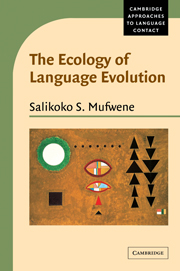Book contents
- Frontmatter
- Contents
- List of illustrations
- Preface
- Acknowledgments
- 1 Introduction
- 2 The Founder Principle in the development of creoles
- 3 The development of American Englishes: factoring contact in and the social bias out
- 4 The legitimate and illegitimate offspring of English
- 5 What research on the development of creoles can contribute to genetic linguistics
- 6 Language contact, evolution, and death: how ecology rolls the dice
- 7 Past and recent population movements in Africa: their impact on its linguistic landscape
- 8 Conclusions: the big picture
- Notes
- References
- Author index
- Subject index
5 - What research on the development of creoles can contribute to genetic linguistics
Published online by Cambridge University Press: 18 December 2009
- Frontmatter
- Contents
- List of illustrations
- Preface
- Acknowledgments
- 1 Introduction
- 2 The Founder Principle in the development of creoles
- 3 The development of American Englishes: factoring contact in and the social bias out
- 4 The legitimate and illegitimate offspring of English
- 5 What research on the development of creoles can contribute to genetic linguistics
- 6 Language contact, evolution, and death: how ecology rolls the dice
- 7 Past and recent population movements in Africa: their impact on its linguistic landscape
- 8 Conclusions: the big picture
- Notes
- References
- Author index
- Subject index
Summary
Identifying genetically related language varieties as dialects of the same language or as separate languages is somewhat reminiscent of assigning populations to the same or different races. It is underlain by some social biases that are seldom discussed explicitly or openly. These are often denied when brought up, and all sorts of nonoperational scientific criteria have been invoked to support distinctions that should at least be re-examined. Genetic linguistics has been influenced more by the cladograms of evolutionary biology than by several interesting research questions behind them.
For instance, blending inheritance, which has to do with social interaction and accounts for offspring inheriting traits from combined parental gene pools, has been accepted as a normal and typical phenomenon in theories of evolution. For some reason, genetic linguists remain committed to the assumption that language is transmitted on an asexual model, in toto rather than piecemeal and reconstructed by every new speaker. Language-mixing has been considered not as a default aspect of language transmission but as an acceptable deviation. A certain expectation for a pure form of a language has led linguists since the nineteenth century to treat creoles and pidgins as seemingly less normal, less regular, less natural, and as not genetically related to their lexifiers. These working assumptions are related to a few others, including the following: a language is an organism and a social institution into which individual speakers are born; it is changed by the latter presumably because something goes wrong.
- Type
- Chapter
- Information
- The Ecology of Language Evolution , pp. 126 - 144Publisher: Cambridge University PressPrint publication year: 2001

